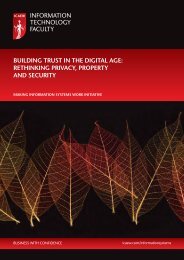Security Effectiveness Framework Study
Security Effectiveness Framework Study
Security Effectiveness Framework Study
You also want an ePaper? Increase the reach of your titles
YUMPU automatically turns print PDFs into web optimized ePapers that Google loves.
<strong>Security</strong> <strong>Effectiveness</strong> <strong>Framework</strong> study<br />
Highlights<br />
101 organisations participated in this study. Of those, 35% had a security effectiveness<br />
score (SES) below the study average, indicating that they are not performing as effectively<br />
as others above the average SES.<br />
The biggest barrier to effectiveness, according to the majority of respondents, is a sufficient budget to accomplish the following:<br />
• Achieve its mission and objectives.<br />
• Ensure IT systems are not disrupted or brought down by attackers.<br />
• Achieve certification from reputable authorities such as ISO, NIST, PCI and others.<br />
• Curtail or minimise data breach incidents.<br />
• Ensure policies are strictly enforced throughout the enterprise.<br />
Based on the SES, organisations are most effective at doing the following:<br />
• Performing timely updates for all major security patches.<br />
• Limiting physical access to data storage devices containing sensitive or confidential information.<br />
• Complying with legal requirements and policy laws and statutes.<br />
• Aligning security programmes with self-regulatory requirements such as ISO, NIST PCI and others.<br />
The main barriers to effectiveness are:<br />
• Being able to make the business case and demonstrate the tangible benefits of the company’s IT security program.<br />
As shown above, the majority do not have the budget or resources to be as effective as possible.<br />
• Being able to prevent or curtail cyber attacks, including advance persistent threats.<br />
• Sixty-three percent do not believe their security budget is sufficient to curtail or minimise data breach incidents.<br />
• Prevent or curtail viruses and malware infections.<br />
The effectiveness metrics that have the greatest impact on security effectiveness are policy enforcement (22%) and<br />
compliance (20%) - see Pie Chart 3, <strong>Effectiveness</strong> metrics.<br />
The input variables that have the most impact are security environment (22%) and governance (21%) - see Pie Chart 2.<br />
Top 5 drivers to a good <strong>Security</strong> <strong>Effectiveness</strong> Rating<br />
– Appointment of a CISO or organisational leader for information security.<br />
– Training and awareness programs on data protection and security for end-users.<br />
– An organisational culture that respects privacy and data protection.<br />
– Executive-level support for security.<br />
– Strong endpoint controls.<br />
Top 5 consequences of a poor <strong>Security</strong> <strong>Effectiveness</strong> Rating<br />
– Inability to achieve a high security posture.<br />
– Insufficient budget or resources.<br />
– Lack of strong perimeter controls.<br />
– Inability to attract and retain credentialed or experienced staff.<br />
– A security strategy that is not consistent throughout the enterprise.<br />
Sponsored by: HP Information <strong>Security</strong> and Check Point Software Technologies Ltd.<br />
Ponemon Institute © Research Report & InstrumentPonemon Institute © Research Report & Instrument



